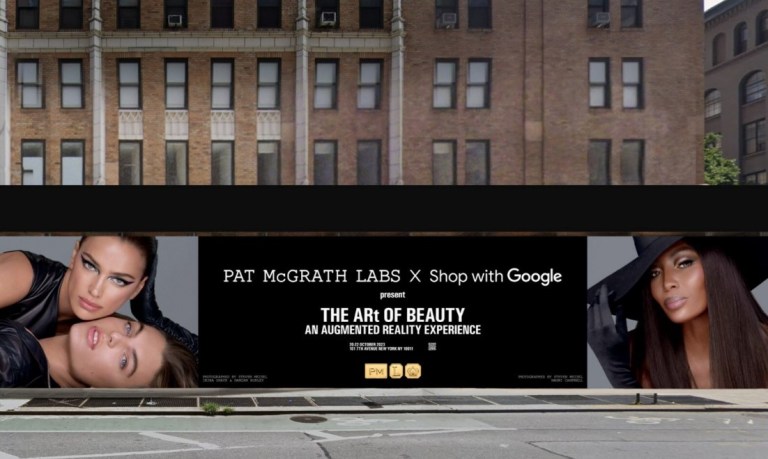However, Snap isn’t seeing the traction we’re talking about. In fact, it’s led to a reshuffling of sorts once again for the social app. But more on that in a bit.
Pat McGrath Labs Foray Into AR
In a team up with Google, Pat McGrath Labs is creating a three-day AR pop-up event called “The Art of Beauty” in New York.
Located at 101 7th Ave. in Manhattan, this pop-up is scheduled to run Oct. 20-22. Its objective is to educate visitors about beauty product shopping techniques and provide them with a sneak peek into the Pat McGrath universe through the use of Google’s AR tools.
The ticketed three-day event will let guests virtually test Pat McGrath Labs’ lip products and Mothership eyeshadow palettes. Attendees can also explore the collection, and schedule a makeup session with a certified member of the Pat McGrath Labs makeup artist team.
In 2020, Google introduced its AR Beauty tool with the aim of enhancing the online beauty product shopping experience by enabling users to virtually sample thousands of eyeshadows, lipstick, and foundation shades from numerous brands, including Pat McGrath Labs. This feature is accessible through Google Search or the Google app on both iOS and Android platforms.
Advertisement: Scroll to Continue
“AR is an incredibly helpful technology for online beauty shoppers of all skin tones and ethnicities because it allows them to envision what a beauty shade looks like on them, or on a model who resonates with them, all before they buy,” said Stephanie Horton, senior director of commerce marketing at Google.
How AR Helps Consumers
AR is elevating consumer confidence in their buying decisions through virtual try-ons and product visualizations, resulting in increased satisfaction and decreased return rates.
In fact, this technology is being adopted by luxury brands such as Maison Valentino and retail behemoths like Walmart.
Back in June, PYMNTS covered the news that Maison Valentino introduced a virtual try-on (VTO) experience for its ready-to-wear collection. This feature is made possible by Wanna, an AR technology company owned by Farfetch.
Read more: Luxury Retailers Try On AI to Reduce Returns
Then there’s Walmart, which recently revealed that it would be looking to AR for customers shopping for clothing and household items.
Through the integration of generative artificial intelligence (AI) and AR technology, Walmart’s objective is to deliver personalized design support to its customers. Shoppers can communicate their budget, theme, and preferences to obtain customized suggestions for room design, allowing them to visualize their ideal space before finalizing their purchase.
Read more: Walmart Experiments With AI and AR to Enhance Shopping Experience
“Customers expect multimodal ways of shopping, and that means brands and retailers need to develop capabilities that can meet customers where they are, however, they need to shop,” Dominique Essig, vice president, Conversational Commerce & Replenishment, told PYMNTS in an interview.
Read more: Walmart Execs Unpack What Its Gen AI Launch Means for Shoppers and Brands
Impact of Gen AI on AR
The rise of generative AI as a powerful tool embraced by retailers is posing challenges for social media companies such as Snap.
“Several things have changed since we first began pursuing our AR Enterprise strategy,” Snap CEO Evan Spiegel wrote in a message to employees Sept. 27.
“First, we believed that we could primarily leverage our existing mobile AR technology. Over time, we also learned that we needed to invest incrementally to support web-based augmented reality, which is both technically complex and less engaging for our customers,” Spiegel continued.
According to Spiegel, the ascent of generative AI has simplified the process for companies to develop virtual try-on tools, creating a more challenging environment for Snap to distinguish itself.
Consequently, Snap opted to terminate its 6-month-old enterprise services unit dedicated to AR.
Read more: Snap Says AI Virtual Try-On Helped Kill Augmented Reality Unit




